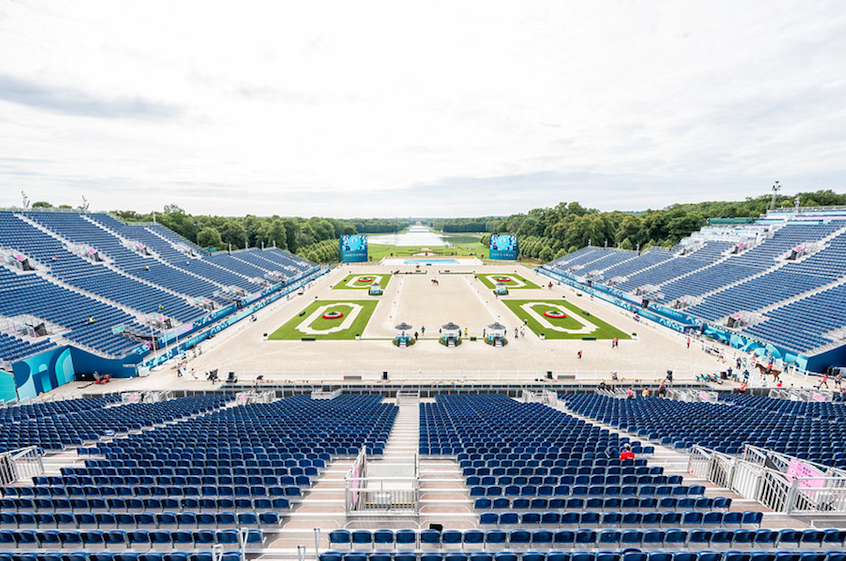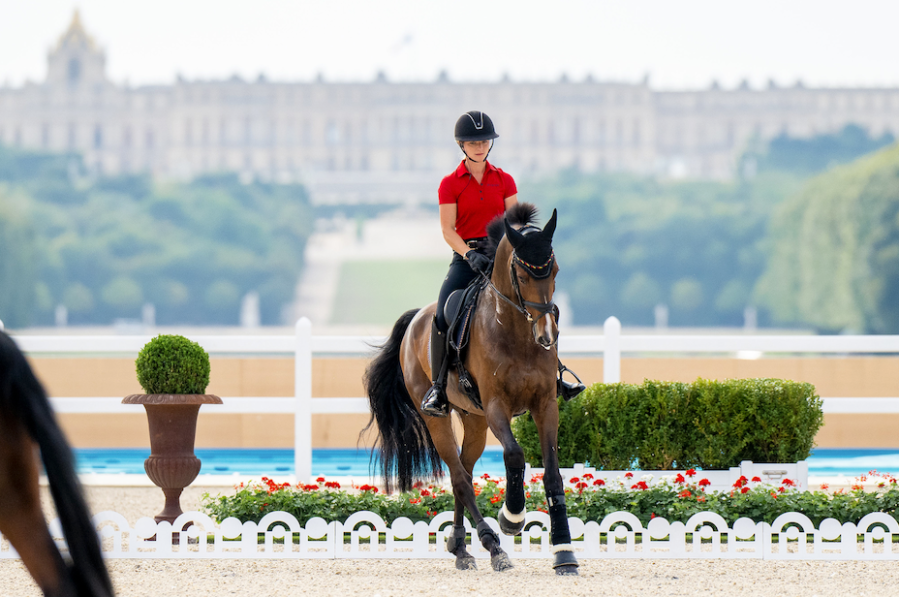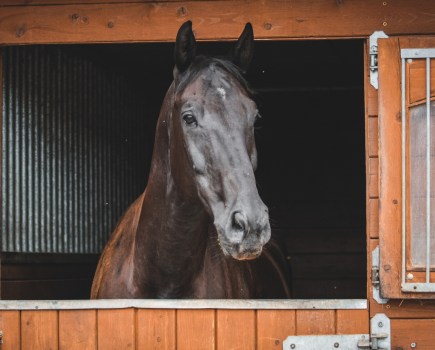The equestrian events for the Olympics in Paris will take place in the Park of the Palace of Versailles, which is steeped in history and has equine links dating back centuries.
Horses had a major presence in Versailles throughout the 17th and 18th century, making the decision for it to host the equestrian events an obvious one. With this in mind, here are some interesting and little-known facts about the Olympic venue…
The Park
- All dressage and showjumping, including para dressage, will be held near the Royal Star esplanade, which is located to the west of the Grand Canal on the edge of the park.
- The cross-country course runs through wooded areas of the park, along the banks of and even across the Grand Canal.
- Visitors to the park rarely walk through these areas and works to clear the woods had to be conducted. These have made the area sounder and have improved its overall condition, thus leaving a positive legacy for the estate.
- The temporary grandstands and facilities have been built to showcase the picturesque setting without harming the exceptional historical heritage of Versailles, which is a UNESCO World Heritage site.
- The Palace of Versailles was the first cultural public institution in France to issue a carbon footprint report.
- Around 40% of the 800-acre park is forestry, with almost 350,000 trees, all of which do their bit to purify the air and combat climate change.
- Each replanted linden tree on the Versailles estate individually captures 20 kilograms of CO2 emissions every year.
The stables
- Horses are stabled by discipline. Each stable is 4m x 3m and has rubber matting. Bedding (straw or shavings) is all sourced in France.
- Equine facilities include:
- 3 sand rings where horses can be lunged
- 6 exercise areas, one of which is covered
- 1 gallop track and a grazing area is accessible throughout the day.
- Access to the stables is restricted to authorised persons, as is the case at all FEI events.
- The stables will be closed for six consecutive hours during the night so that the horses can rest and sleep undisturbed.
- The stables are covered by surveillance cameras and stewards will quietly carry out regular checks of the horses throughout the night. If there are any problems, the relevant groom will be contacted.
Horse welfare
- 3 horse ambulances will be on site every day, increasing to eight ambulances on cross-country day.
- There are four members of the FEI Veterinary Commission, plus four official vets and five treating vets.
- There are also two imaging vets plus specialist volunteers, a laboratory vet and two technicians, and an equine physical therapist vet on site.
- A temporary veterinary clinic has been set up close to the stables and is open between 6am and 10pm, with emergency assistance available around the clock.
- The referral hospital is Grosbois Equine Veterinary Clinic, which is 40 minutes from Versailles.
- Strict biosecurity measures include every horse’s rectal temperature being taken and reported each morning and night.
- Foot mats with disinfectant and hand sanitiser must be used every time a person enters and exits the horse area.
- There are two farrier team leaders plus specialist volunteers
- There are also team vets and permitted equine therapists on site.
Cross-country day
- 1 vet cross-country team leader
- 12 sector vets (1 emergency vet and 1 anaesthetist)
- 22 vets will be placed at various fences around the cross-country course
- 3 vets will be located at the canal
- 2 vets will be in the cooling zone
- As well as 8 ambulances, there will be 2 vans, 10 towing vehicles, 7-10 golf carts for rapid emergency transportation of team staff
The Palace
- The Palace of Versailles is one of the greatest achievements in French art and architecture of the 17th century.
- The original small brick and stone hunting pavilion was built in 1623 for Louis XIII, King of France from 1610 to 1643.
- It was later transformed and extended by his son, Louis XIV, the Sun King (King of France from 1643 until his death in 1715).
- At the time Versailles was only a village. It was destroyed in 1673 to make way for the new town Louis XIV wished to create.
- In 1682, the King installed the Court and government at Versailles, which became the centre of the French political and social system known as l’ancien régime (the old rule).
- The term ‘château’ was used to refer to the rural location of a luxurious residence, as opposed to an urban ‘palais’ (palace). It is still common to refer to the ‘Palais du Louvre’ in the heart of Paris and the ‘Château de Versailles’ out in the country.
- The Great and Small Stables were commissioned by Louis XIV to accommodate the household’s horses and became the greatest royal construction project for housing horses ever undertaken.
- Work on both buildings was launched in anticipation of the move of the court and government to Versailles. The project was managed by architect Jules Hardouin-Mansart, the Palace’s main architect, and was executed in just three years from 1679 to 1682.
- The stables are opposite the Palace and their location testifies to the important role of horses in the history of France.
- During the reign of Louis XIV, the Royal Stables were one of the most important departments in the King’s House.
- Nearly 1,500 men looked after the more than 2,000 horses that were stabled there at any time.
- Today, the Royal Stables are home to collections and different establishments, such as the National School of Architecture of Versailles, the Centre for research and restoration of the museums of France, and the Equestrian Academy of Versailles.
The riders

The Olympic stadium in the Park of the Palace of Versailles
- In Paris, there will be 65 starters in the eventing, 60 starters in dressage and 75 in the showjumping.
- Equestrian has been in the Olympic Movement for 112 years, celebrating its centenary at the London 2012 Games.
- Germany is by the far most successful nation in equestrian events at Olympic Games, having won a total of 45 team medals (including 26 gold) and 50 individual medals (18 of these being gold).
- Dressage rider Isabell Werth, representing Germany, has won the most medals. She has 12 medals to her name from six Olympic appearances, including individual gold in 1996 with Gigolo, and team gold in 1992, 1996, 2000, 2008, 2016, and 2020.
- The French rider with the most Olympic appearances is event rider Nicolas Touzaint, who has competed in five of the last six Olympic Games, missing only Rio in 2016.
- Paris will be Nicolas’ sixth Olympic Games. He has won two Olympic medals (team gold in Athens 2004 and team bronze in Tokyo 2020).
- A total of 49 nations will compete in equestrian at the Paris 2024 Olympic Games. This is the second highest number after Tokyo 2020, where 50 nations competed.
The sport
- 17 nations will participate in all three disciplines.
- 10 nations of these have teams entered: France (host nation), Australia, Belgium, Canada, Great Britain, Germany, The Netherlands, Poland, Sweden, USA.
- 7 nations are represented by teams or individuals in all three disciplines:
- Austria (Teams in dressage and jumping; two individuals in eventing)
- Brazil (Teams in jumping and eventing; one individual in dressage)
- Denmark (Team in dressage; one individual in jumping and one in eventing)
- Ireland (Teams in jumping and eventing; one individual in dressage)
- Portugal (Team in dressage; one individual in jumping and one in dressage)
- Spain (Teams in jumping and dressage; two individuals in eventing)
- Switzerland (Teams in jumping and eventing; one individual in dressage)
- Lithuania and Moldova will be represented at Olympic equestrian events for the first time.
- Lithuania has one individual in jumping and one individual in dressage.
- Moldova has one individual in dressage.
- Estonia and Thailand are represented in Olympic showjumping for the first time (both have one individual entered).
- The UAE has its first team entered in the showjumping.
- India and Venezuela have one individual competing in the dressage events for the first time.
- Morocco has one horse and rider competing in the eventing for the first time.
Qualifying for the Olympics
There is a two-year qualification process for every horse and rider competing in the Paris Olympics. The process began at the FEI World Championships in 2022.
Each horse and rider must have achieved the relevant Minimum Eligibility Requirements (MERs) and have Certificates of Capability verified by the FEI.
No past Olympic title holder in equestrian (team or individual) is automatically eligible for the Paris 2024 Olympic Games.
Olympic stalwarts
- One rider is competing in his eighth Olympics. Brazilian showjumper Rodrigo Pessoa rode at the 1992, 1996, 2000, 2004, 2008, 2012, 2020 Games and won three medals (individual gold at Athens 2004 and team bronze at Atlanta 1996 and Sydney 2000).
- Britain’s dressage rider Carl Hester will line up for his seventh Games, as will Japan’s Taizo Sugitani (jumping), Belgium’s Karin Donckers (eventing) and Germany’s Isabell Werth (dressage).
- Seven riders are riding at their sixth Olympics:
- Steffen Peters (USA) in dressage
- Nicolas Touzaint (France) in eventing
- Rolf-Goran Bengtsson (Sweden) in jumping
- Victoria Max-Theurer (Austria) in dressage
- McLain Ward (USA) in jumping
- Steve Guerdat (Switzerland) in jumping
- Ramzy Al Duhami (Saudi Arabia) in jumping
Youngest & oldest riders
- The minimum age to compete in dressage is 16 for riders and eight for horses.
- In eventing, riders must be 18 and horses must be eight.
- In showjumping, riders must be 18 years of age and horses must be nine.
- Age as of 31st December 2023 was the cut off for the Paris Olympics. So any horse or rider who met the minimum age required on or after 1 January 2024 are too young to compete.
- The youngest rider competing is Omar Abdul Aziz Al Marzooqi for the UAE, who is 21 years old and will compete in showjumping.
- The oldest rider is Juan Antonio Jimenez Cobo from Spain, who is 65 years old and will compete in dressage.
View our Olympic timetable and find out how to watch
Main image: Germany’s Julia Krajewski is pictured riding Nickel 21 in the main arena in front of Palace of Versailles at the Paris Olympics. Image by FEI/Benjamin Clark
Related content
- Olympic eventing: how it works and useful facts about Paris
- Paris Olympics eventing form guide: fifth gold for Team GB?
- ‘An incredible place’: Olympic eventers settle in at Versailles
- Carl Hester and Andrew Hoy share Olympic memories and secrets to longevity ahead of Paris 2024
- Becky Moody promoted to Team GB dressage trio and Andrew Gould confirmed as alternate for Paris Games










